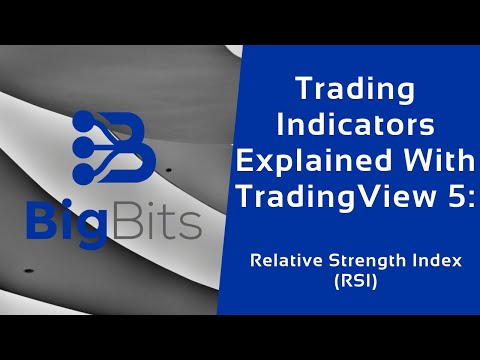YouTube Video
YouTube Video Transcript
[Music] hey this is David for big bits and in this video we’re gonna talk about the RSI indicator that is the relative strength index this indicator is one that I’m very familiar with I use it a lot I’ve made several different indicators and strategies based off the RSI so I’m pretty familiar with it and in this video we’re gonna take a look at how you can use this and look at the math behind it so you can kind of understand what’s actually going on to calculate the RSI because as if you’ve seen this series you’ll probably notice that if you know how the math is done for the indicators sometimes you can predict kind of how the indicator is going to move depending on what the next candle is gonna do so you can think you know if this candle is going to be red then it’s gonna go down but in certain situations you can say well if the candle is red it’s actually gonna go down a lot because of how the calculation works instead of just a little and depending on how big it is so things like that or what we look for but let’s go ahead and take a look with the trading view all you have to do to add this to your chart is just type in RSI when you go to add an indicator it’s the first one on the built in scripts you can see it goes from 0 to 100 there’s two lines and arranged between those that is all these lines I should say represent overbought and oversold which is used to help try and determine where momentum might end or help you see where the trends are currently now we’ll go into more detail on how the RSI is actually used but for now we’re also going to take a look at some code on how you can actually add the RSI to your chart it’s very simple you just use an RSI function it’s built in you pass in what source you want to use which is the closing price by default which is the last price of candle 14 periods back is the standard for RSI and when you do that and you plot it on the chart let’s add this to our chart you can see it plots that line that we saw with the other indicator I did plot anything else so you can’t see the overbought and oversold boundaries but you can see that you can easily add this to your chart now some of my other videos I’ve went through and I’ve done all the math for these there’s actually quite a lot going on with the RSI and it would have made this video very long we’re still gonna go over the math but I’m not actually gonna type it out for you and do this sort of live coding that we have done on some of the videos to show you this but the the resources we’re gonna look at does a very good job in explaining how it’s actually calculated so you can get a really good understanding on how things actually work so now that we’ve got that edit in there let’s go ahead and minimize our pun script area take the RSI out here and let’s add the default one back in there we go this is our default RSI indicator on trading view let’s take a look at the relative strength index I’m gonna post this resource link in the description for the video below so if you’re watching you can just take a look down there and you have the link directly to this document but that we’re gonna read over some of these I’m gonna try and summarize what I can but then we’re gonna take a more in-depth look at the math when that comes up and some of this is gonna be repetitive the relative strength index is a momentum indicator that measures the magnitude of recent price changes to evaluate overbought or oversold conditions in the price of a stock or other asset the RSI is displayed as an oscillator I mentioned that reading from 0 to 100 now the key takeaways you don’t really need to know it was developed in 1978 but if you want to there it is and it compares bullish and bearish price momentum plotted against the graph and the signals as we’ve mentioned our overbought and oversold but it actually gives you the levels that are typical for the indicator which are 70 percent for overbought and 30% for oversold you probably won’t see them labeled as percentages you’ll probably just see numbers so you’ll probably just see 70 and 30 when you look at a chart now the formula is actually several steps to calculate and there’s actually a lot going on if you just look at it it may not look like a lot but there is especially if you have to try and code an RSI calculation there is a lot of references to previous candles that you have to look at and you have to make sure all the data is correct and you’re looking at everything correctly so let’s go ahead and get started the first step on the RSI is we have to get our average gain and our average loss and we’ll do the rest of this later but the first thing you need is your average gain and your average loss let me zoom in that’ll probably help quite a bit here so we have an average gain divided by an average loss now what the average gain is is for the RSI period that you’re using so if you’re using a 14 period RSI the calculation here for the average gain is going to look back through all all of the 14 most recent candles and it’s gonna get the gain on all of the candles that were green so it’s gonna tell you how much the gain was in a percentage on each of those candles and it’s also gonna go back and find the average loss and it’s very important that you know that the average gain only comes from candles that were green or closed with the higher price and the average loss only includes the average loss of candles that were down in price so that’s very important to note because otherwise there’s really no point in separating the gain out from the law so you would just have the same number so once we do that we can do the rest of this calculation that’s really not too difficult the rest of it it’s just basic math knowing how you get the average gain and the average loss is actually quite important and I will point out actually there’s one thing I forgot is that the average gain you actually divide the average gain instead of dividing it by how many candles actually had a gain you divide it by the period of the RSI so with a 1% average gain with a 1% average gain you would divide that by 14 because that’s your RSI period even if you only had one candle that had a 1% gain and that was your average gain your 14 when you divided about 14 you always do that because that’s whatever your period is so if you use the 15 period you would divided by 15 here etc but it’s important to note that you don’t divide the 1% by the amount of candles that actually had a gain you do it with the actual period of the RSI and that’s confusing please leave a comment that might be very confusing to some of you if you haven’t seen it before now after we do that there is a bit more there’s a second step we have our average gain calculated and now we have to calculate the actual RSI value and in order to calculate the actual RSI value we need to look at our previous gain our previous average gain 1% divided by our average loss 0.8% but on the next candle here when we do look back at those numbers we have to multiply those by 13 because they represent 13 parts of the 14 period RSI calculation and then you add in your current one and this kind of gives you an average of how these things work the previous average gain times your period minus 1 don’t think this is always 13 when it goes back here it’s always your period minus 1 plus the current one which makes up your entire RS period RSI period excuse me then you just do the rest of the math and it spits out these wonderful lines that you see here well the the wonderful line that you see here now as far as how to actually use the RSI there’s quite a bit of resources for that now the the most common way is to kind of look for a trend it’s very easy to notice that you know the RSI has been above 50 for an extended period that the trend must be upward it’s below 50 and must be down that’s one way that it can be you can see here the RSI indicator can remain an overbought territory for extended periods while stock is in an uptrend that’s pretty much just what I’ve said and it can stay in oversold territory for a long time while stock is in a downtrend that’s because it’s working with the momentum and in order for it to change the trends on the RSI the momentum kind of has to change so that’s important to know the oversold reading in an uptrend is likely much higher than 30% and an overbought reading on the RSI during a downtrend is much lower than the 70% level now these are the default levels that they talked about earlier in the article here and I’ll go through down here and show you what I mean I think they had a good picture of this where is it maybe they don’t but you can see there are adjusted overbought levels that you can use you can tell that if you were in a downtrend for a long time here if the price were to bounce off of the 50 then the trend might continue to be down and when you’re in an uptrend you might change your threshold up or down respectively giving it a little bit of room to capture a bottom or try to capture a bottom and maintain the trend that might be a bit confusing but something that hopefully isn’t as computing is the examples of divergences there are bullish and there are bearish divergences and the way a bullish divergence is seen is that you have an oversold reading followed by a higher low that matches correspondingly to lower lows in the price now essentially what this means is that and I’m trying to find a good example here ok well let’s see I should have probably prepared this before I started but it’s always good to go back and take a look here here we go finally we have a bullish divergence you can see that the RSI had a higher low and the price had a lower low in that same period this is what you would call a bullish divergence and it would often times signal the trend change now the opposite is also true for a bearish divergence so you would look for the exact opposite a lower high in the RSI and a higher high in the price over the same period and they also give you an example here of swing rejections and they have it laid out pretty well here the RSI falls into an oversold territory it crosses back above it and then it dips back down and then it breaks out of that recent high you can see they’ve got that pointed out really well and when oversold came back up dipped and broke out of its previous high after it came out from being oversold which is a pretty simple example of a kind of a breakout so I think that’s pretty much going to do it they also give you the bullish or the bearish example excuse me I think that’s pretty much gonna do it for RSI video other than I’m going to show you a couple of other things that are available that I have worked on that you might enjoy so if you’re on trading view you can take a look in the public library you can search for a few of my different indicators here I have one that’s called RSI call-outs this will allow you to show labels on your chart for when RSI values reach above a certain level so for example our overbought is set to 80 and once a candle went over 80 on the RSI here it printed a label on the chart so you can see it so instead of having to waste your screen space and show that line continuously it’s only going to show you what you really care about now another one that I use sometimes is also the smooth RSI this is another one that I have done let’s see where is this that I did here we go this one is just your RSI calculation you can see the red area is overbought the green area is oversold but there’s also an orange line that isn’t typically part of an RSI calculation this is a smooth line which uses a moving average to calculate a smoother line of the RSI and if you’re curious about moving averages I have other videos about moving averages in this series so please go check those out otherwise that is it for the video today make sure to check out my profile on tradingview because there you can see all of the scripts that I’ve done just click on my profile link in the description and go to the scripts tab and you can see all of those there but other than that I appreciate you watching thank you and have a nice day [Music]
YouTube Video Description
< br/> #bitcoin #crypto #cryptocurrencies #tradingview
Video resources:
https://www.investopedia.com/terms/r/rsi.asp
Website: https://bigbits.io
Discord: https://discord.gg/rapMn4z
Twitter: https://twitter.com/BigBitsIO
Facebook: https://www.facebook.com/BigBitsIO/
GitHub: https://github.com/BigBitsIO
TradingView: https://www.tradingview.com/u/BigBitsIO
Referrals……
Trade on Coinbase: https://www.coinbase.com/join/johnso_dxz
TradingView: https://www.tradingview.com/gopro/?share_your_love=BigBitsIO
Brave Browser: https://brave.com/big406
LightNite Game: https://lightnite.io/ref=BigBits
VIEW ALL HERE: https://bigbits.io/bigbits-referrals/
DISCLAIMER: All my videos are for educational and entertainment purposes only. Nothing in this or any of my videos should be interpreted as financial advice or a recommendation to buy or sell any sort of security or investment including all types of crypto coins and tokens. Consult with a professional financial advisor before making any financial decisions. Investing in general and particularly with crypto trading especially is risky and has the potential for one to lose most or all of the initial investment. In simple terms, you are responsible for your actions when trading.



